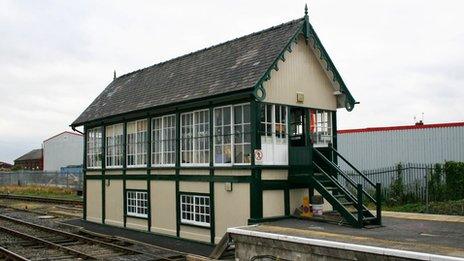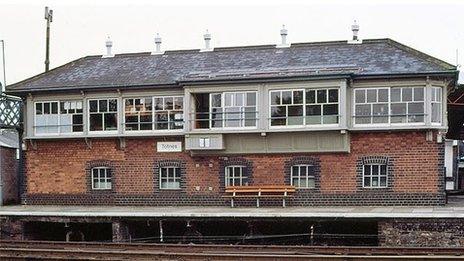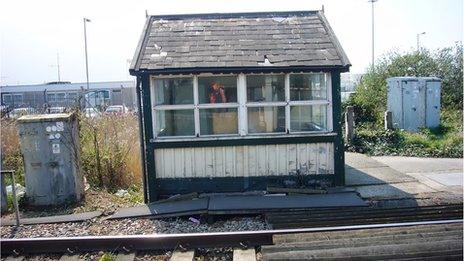Railway signal boxes granted Grade II listed status
- Published
- comments

Built in 1888, the Bury St Edmunds Yard signal required four resident signal men to work the levers

The Skegness signal box in East Lindsey was at the end of the Poacher line which ran from Nottingham

Hebden Bridge signal box was fitted with 36 levers and is one of only a handful of Lancashire and Yorkshire Railway boxes to survive

The decommissioned signal box in Totnes, Devon, has been converted into a cafe

The Downham Market signal box in Norfolk has been well preserved with wood blocks cut to resemble stone

The Grain Crossing signal box in Medway, Kent was responsible for the diverging lines on the approach to the now disused Port Victoria
Twenty-six of the "rarest" signal boxes in England have been granted Grade II listed status by the Department for Culture, Media and Sport.
Culture minister Ed Vaizey said interest in trains and railways was one of the country's "most endearing and enduring national preoccupations".
The joint venture, between English Heritage and Network Rail, is part of a 30-year plan to modernise the railways.
A number of mechanical boxes are being replaced by regional operating centres.
"These are very special buildings, at one time a familiar sight on our railway system," said English Heritage's senior investigator John Minnis.
The preservation of 26 "highly distinctive" signal boxes would provide a "window into how railways were operated in the past," he added.
David Sillito visits a signal box in Norfolk
Hebden Bridge signal box, which was built in 1891, will be preserved as it has a "time warp quality" and has retained its original 1914 signage.
English Heritage said some of the listed buildings could be "rejuvenated" as cafes or museums, such as the 1923 signal box in Totnes, Devon.
In the 1940s there were more than 10,000 signal boxes in the UK. Now fewer than 500 mechanical signal boxes are still in use, according to Network Rail.
The "difficult and expensive" operating buildings limit the "potential of the rail network", it said.
Network Rail said modernisation plans were aimed at improving railway technology so there are fewer delays and higher capacity.
Signal platforms were first introduced in the 1840s, but British engineer John Saxby first created a building housing levers in 1857.
They were designed by private contractors and railway companies, such as Great Western Railway, leading to a huge variety of designs.
The new designations are as follows:
North
Hebden Bridge, Calderdale, West Yorkshire
Hensall, Selby, North Yorkshire
West
Bournemouth West Junction, Poole, Dorset
Lostwithiel, Restormel, Cornwall
Marsh Brook, Shropshire
Par, Restormel, Cornwall
Totnes, S Hams, Devon
East
Brundall, Broadland, Norfolk
Bury St Edmunds Yard, St Edmundsbury, Suffolk
Downham Market, Kings Lynn and West Norfolk, Norfolk
Skegness, East Lindsey, Lincolnshire
Thetford, Breckland, Norfolk
Wainfleet, East Lindsey, Lincolnshire
Wymondham South Junction, South Norfolk, Norfolk
South
Aylesford, Tonbridge and Malling, Kent
Canterbury East, Kent
Cuxton, Medway, Kent
Eastbourne, East Sussex
Grain Crossing, Medway, Kent
Littlehampton, West Sussex
Liverpool Street, City of London
Maidstone West, Maidstone, Kent
Rye, Rother, East Sussex
Shepherdswell, Dover, Kent
Snodland, Tonbridge and Malling, Kent
Wateringbury, Maidstone, Kent
Upload, external your photos or send them to yourpics@bbc.co.uk
- Published15 July 2013
- Published1 June 2013